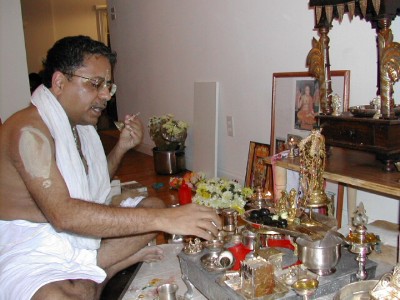
POOJA : A ritual of worship in Vedic Hinduism
by M.G. Prasad

A pooja is a ritual of worship and adoration of the GOD (One Supreme Being) in the tradition of Vedic (Hindu) religion. Hinduism refers to Sanatana or Vaidika Dharma which means eternal principles of life as per the Vedas. One GOD as per the Vedas is the One Supreme Being (Bramhan) ultimately responsible for Generation, Operation and Dissolution of everything. Freedom (Moksha) from bondage and desires is the ultimate aim of Sanatana Dharma. The three paths need to be integrated in Vedic Hindu spiritual approach are devotion, knowledge and action. A pooja even in its simple form is a synthesis of these three paths. A pooja is based on devoted and knowledgeable actions.
A pooja also connects all the senses dealing with sound, touch, sight, taste and smell to sacredness through components such as sculpture or pictures of Gods, chants, prayers, bhajans, flowers, fruits, incense, milk, water etc. A pooja provides a spiritual experience not only to the performer but also to the participants. A pooja also can be seen as a loving act of treating an invited guest to one's home. As one treats his guest with respect and love by various offerings, in a pooja also similar offerings are made to God.
A pooja has two main parts namely internal (mental) and external (ritualistic). The internal (mental) worship is very important after which one begins to perform the external part. In the external worship the various offerings can be classified into 16 Offerings to God, namely,1) Invoking God into altar through sculpture or picture, 2) a Seat, 3) Washing feet, 4) Washing hands, 5) Water for sipping, 6) Sacred bath, 7) Sacred cloth, 8) Sacred thread, 9) Sandal paste, 10) Flowers, 11) Incense sticks, 12) Waving of oil lamp, 13) Food, 14) Betel leaves and coconut, 15) Waving of camphor light, 16) Clockwise circumambulation and Prostration. Each of the above is offered with mantras and prayers in Sanskrit. Also, sounds of bell and conch are used in the pooja. A specific manifestation of the Supreme Being is chosen for the pooja depending on the wish of the congregation or family. Usually a Hindu family maintains an altar or pooja room in the home as sacred space for performing pooja . In Hindu temples, priests perform poojas.
A pooja at home or temple is a synthesis of devotion, knowledge and
action that provides spiritual tranquility by connecting to Omnipresent
God. In the words of my Sriranga Sadguru, "the worship of deities and rituals
in a home or a temple should be carried out with child-like loving mind
by the devotees as little children play with joy using their toys as medium".
Also, In Bhagavadgita (9-26) Lord Krishna says that "I will accept from
them even a leaf or a flower or a fruit or water, when it is offered with
love, devotion and purity of heart"




